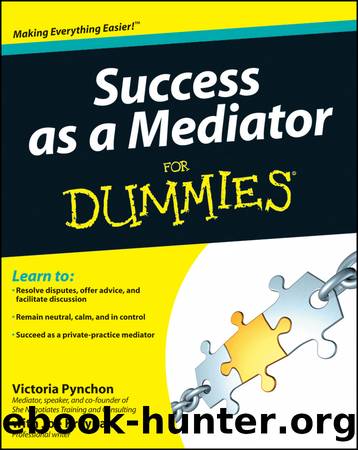Success as a Mediator For Dummies by Victoria Pynchon

Author:Victoria Pynchon
Language: eng
Format: epub
Publisher: Wiley
Published: 2012-03-07T00:00:00+00:00
To move the parties past clustering error, ask diagnostic and reality-testing questions that help the parties recognize the low probability of the suspected malicious intent. For instance, the likelihood that the presidents of five companies met secretly for the sole purpose of crafting a plan to drive a smaller company out of business is slight. Ask questions to reveal holes in the conspiracy theory, such as: What did these five presidents hope to gain? What kind of trouble would the presidents have gotten into with the SEC had they been caught? With so many people involved, how could they have kept it a secret? How much time and effort would be required to coordinate and execute such a plan? In probing, the conspiracy theory typically unravels under scrutiny and problem solving can begin. In some cases, however, the âparanoidâ party has sufficient facts to prove his suspicions.
In a recent mediation concerning the transportation of goods from one city to another, the president of the defendant moving company expressed his belief that the plaintiff and his attorney werenât simply seeking damages for lost goods but were engaged in a conspiracy to drive him out of business. The facts were not in dispute. The plaintiffâs attorney also represented the interests of a well-known brand-name moving company. The goods that the plaintiff claimed had been damaged were unusually pricey â a couple of museum quality sculptures. The defendant was a small, struggling moving company on the verge of bankruptcy.
Its president put together unusually high cost goods + attorney for major moving company + unrelated marketplace losses in a tough economy and concluded that all three parties â the plaintiff, the plaintiffâs attorney, and the major moving company â were conspiring to drive him out of business. This is the common type of clustering error that mediators routinely encounter and that often creates an impasse. In this case, I helped the defendant understand that even were he able to prove his theory (difficult at best), he didnât have a lawyer and hadnât made a legal claim based on the alleged conspiracy. Doing so would be expensive and difficult to prove. On the other hand, the legal claim that was being made was far easier to defend based on his contention that he had simply withheld the sculptures for nonpayment and was willing to return them in exchange for full payment of his modest moving fee.
Download
This site does not store any files on its server. We only index and link to content provided by other sites. Please contact the content providers to delete copyright contents if any and email us, we'll remove relevant links or contents immediately.
| Antitrust | Civil Law |
| Emigration & Immigration | Federal Jurisdiction |
| Housing & Urban Development | Indigenous Peoples |
| Land Use | Public |
| Public Contract | Public Utilities |
| Urban, State & Local Government |
Machine Learning at Scale with H2O by Gregory Keys | David Whiting(4194)
Killers of the Flower Moon by David Grann(3971)
Oathbringer (The Stormlight Archive, Book 3) by Brandon Sanderson(2901)
Will by Will Smith(2795)
Once Upon a Broken Heart by Stephanie Garber(2686)
Guns, Germs and Steel by Diamond Jared(2304)
Borders by unknow(2232)
It Starts With Us (It Ends with Us #2) by Colleen Hoover(2203)
Friends, Lovers, and the Big Terrible Thing by Matthew Perry(2126)
The Room Where It Happened by John Bolton;(2105)
The Color of Law by Richard Rothstein(1887)
HBR's 10 Must Reads 2022 by Harvard Business Review(1779)
The Strength In Our Scars by Bianca Sparacino(1778)
A Short History of War by Jeremy Black(1764)
Water Rights and the Environment in the United States by John Burch(1645)
Examples & Explanations: Administrative Law by William F. Funk & Richard H. Seamon(1604)
515945210 by Unknown(1602)
A Game of Thrones (The Illustrated Edition) by George R. R. Martin(1594)
That Every Man Be Armed by Stephen P. Halbrook(1549)
